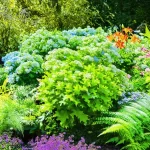Drought tolerant hydrangeas are a remarkable choice for any garden enthusiast seeking vibrant blooms while reducing water usage. These stunning shrubs not only beautify your landscape but also showcase resilience in the face of climate challenges. Let’s dive into the captivating world of drought tolerant hydrangeas, exploring their varieties, care tips, and Other essential aspects that make them a perfect choice for sustainable gardening.
What is Drought Tolerant hydrangea?
Drought tolerant hydrangeas refer to specific varieties of the popular hydrangea plant that can withstand dry conditions once established. Plants in this category have adapted traits that reduce water loss, making them suitable for regions that experience prolonged dry spells. Notable examples include the Oakleaf hydrangea (Hydrangea quercifolia) and certain cultivars of Hydrangea paniculata, recognized for their hardiness and beautiful blooms.
Benefits of Drought Tolerant Hydrangeas
- Reduced Water Usage: Once established, these plants require significantly less water compared to traditional hydrangeas.
- Sustainability: Helps gardeners commit to environmentally friendly practices by conserving water.
- Aesthetic Appeal: Provides vibrant colors and full blooms that enhance garden aesthetics.
- Hardiness: Many varieties are resistant to pests and diseases, requiring minimal intervention once planted.
| Benefit | Description |
|---|---|
| Reduced Water Usage | Lower need for irrigation once established |
| Sustainability | Eco-friendly choice, helping conserve important resources |
| Aesthetic Appeal | Beautiful flowers bring life to any garden |
| Hardiness | Resilient against drought and various environmental stressors |
Top Drought Tolerant Hydrangea Varieties
1. Oakleaf Hydrangea (Hydrangea quercifolia)
The Oakleaf hydrangea is a standout in the drought-tolerant category. This native Southeastern U.S. plant can reach heights of 6 feet. Its oak-like leaves add to its charm, turning a striking reddish-brown in the fall.
- Ideal Conditions: Prefers well-drained soil and can thrive in partial to full sun.

2. ‘Little Quick Fire’ (Hydrangea paniculata)
This dwarf variety produces beautiful, conical blooms that start white and transition to blush pink. It’s not only drought-resistant but also has an early blooming season.
- Size: Stays compact, reaching about 3 feet in height.

3. peegee hydrangea (Hydrangea paniculata ‘Grandiflora’)
PeeGee is known for its immense flower clusters and ability to thrive in various conditions. It’s especially tolerant of heat and drought once established.
- Ideal for: Larger gardens where its upright growth can be fully appreciated.

4. limelight hydrangea (Hydrangea paniculata ‘Limelight’)
This variety produces large, greenish-white flowers that change to pink as they mature. Limelight is well-known for its heat tolerance and drought resistance.
- Height: Can reach up to 8 feet tall and 6 feet wide.

Planting and Care Tips for Drought Tolerant Hydrangeas
Soil Preparation
Well-draining soil is crucial for the success of drought tolerant hydrangeas. Here’s a simple guide to soil preparation:
- Select a Location: Choose a spot that offers either full sun or partial shade depending on the variety.
- Amend the Soil: Mix organic matter, like compost, into the soil to enhance drainage and nutrient content.
Watering Guidelines
While drought tolerant hydrangeas are more resilient to dry conditions, proper watering during the establishment phase is essential:
- Initial Watering: Water deeply once or twice a week during the first growing season.
- Post-Establishment: After the first year, reduce watering frequency, allowing the soil to dry out between watering.
Mulching
Applying a thick layer of mulch around the base of the plants helps retain moisture and suppress weeds. Organic materials like chopped leaves or bark work exceptionally well.
Pruning
Regular pruning helps maintain shape and encourages healthy growth. Here’s a basic pruning guideline:
- Timing: Late winter or early spring is ideal for pruning most hydrangeas.
- Method: Remove dead or damaged stems, and prune back one-third of the oldest stems to the ground.
Frequently Asked Questions (FAQ)
Are Hydrangeas Drought Tolerant?
Yes, certain varieties, such as the Oakleaf and specific cultivars of Hydrangea paniculata, are drought tolerant once established. They require less water than traditional hydrangeas.
Do Drought Tolerant Hydrangeas Require Full Sun?
Most drought tolerant hydrangeas can handle full sun, but some varieties benefit from partial shade, especially in very hot climates. Check the specific needs of the variety you choose.
How Long Does it Take for Drought Tolerant Hydrangeas to Become Established?
Typically, hydrangeas take about one to two growing seasons to become fully established and achieve their drought-tolerant capability.
Can I Grow Drought Tolerant Hydrangeas in Containers?
Yes, you can grow drought tolerant hydrangeas in containers, but ensure the pot has adequate drainage and monitor watering closely, especially in hot weather.
What Pests Affect Drought Tolerant Hydrangeas?
Drought tolerant hydrangeas are generally resistant to pests, but keep an eye out for aphids, spider mites, and Japanese beetles. Early detection is key to managing these pests effectively.
For further detailed information regarding hydrangeas and their care, you can refer to the Oregon State University Extension Service.

Harnessing the beauty of drought tolerant hydrangeas allows you to create a stunning garden that thrives with less water. With the right knowledge and care, these resilient plants will bring color and life to your outdoor spaces while being kinder to the environment. Enjoy the vibrant blooms without the burden of excessive watering!


